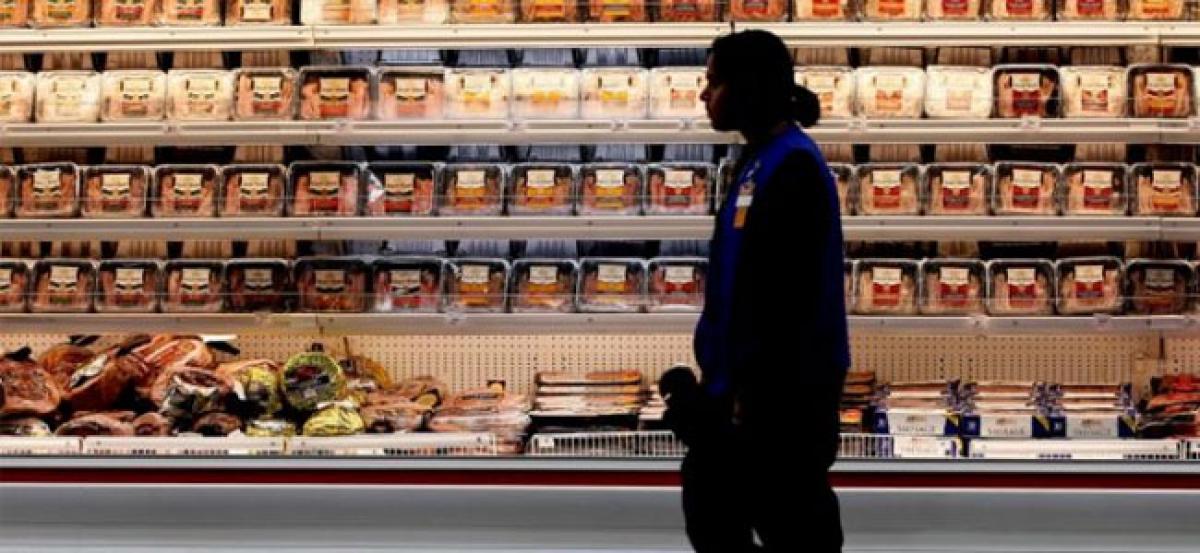Live
- ‘Militant’ bodies airlifted to Manipur after post-mortem in Assam
- Jaipur Open 2024: Baisoya makes a grand comeback to clinch title in marathon playoff against Rashid Khan
- Jamaat-e-Islami Hind President asks cadre to reach out to larger society beyond community
- Why PM mum on Caste Census, removing 50 pc quota limit: Rahul Gandhi
- Barrackpore Municipality Vice-Chairman found dead at home, suicide note suggests blackmail
- Selection trials announced for 20th Asian Senior Women's Handball Championship
- Women’s Asian Champions Trophy: India register 3-0 win over Olympic medallist China in Rajgir
- Sr Men's National Hockey: Odisha overcomes Haryana to secure maiden title
- Even Trinamool leaders not safe in Bengal: BJP
- K’taka: Police complaint lodged against petitioner in MUDA case
Just In

U.S. retail sales increased broadly in April while consumer prices rebounded, pointing to a pickup in economic growth and a gradual rise in inflation that could keep the Federal Reserve on track to raise interest rates next month.
WASHINGTON: U.S. retail sales increased broadly in April while consumer prices rebounded, pointing to a pickup in economic growth and a gradual rise in inflation that could keep the Federal Reserve on track to raise interest rates next month.
The reports on Friday added to labor market data in suggesting the near stall in economic activity in the first quarter was an anomaly. But a moderation in year-on-year inflation led financial markets to dial down expectations of at least two more rate increases this year.
"The economy picked it up a notch from the slow start earlier this year, but the inflation fires are not burning brightly and this will likely keep the Fed on just a gradual pace for interest rate hikes later this year," said Chris Rupkey, chief economist at MUFG Union Bank in New York.
The Commerce Department said retail sales rose 0.4 percent last month after an upwardly revised 0.1 percent gain in March. Sales rose 4.5 percent in April on a year-on-year basis.
Economists had forecast overall retail sales increasing 0.6 percent last month. Excluding automobiles, gasoline, building materials and food services, retail sales gained 0.2 percent after advancing 0.7 percent in March.
These so-called core retail sales correspond most closely with the consumer spending component of gross domestic product.
The economy grew at a 0.7 percent annualized rate in the first quarter, held back by the weakest increase in consumer spending in more than seven years. The Atlanta Fed estimates GDP will rise at a 3.6 percent pace in the second quarter.
In a separate report on Friday, the Labor Department said its Consumer Price Index rose 0.2 percent after dropping 0.3 percent in March. The rise in prices suggested that March's decline, which was the first in 13 months, was an aberration.
In the 12 months through April, the CPI increased 2.2 percent. While that was a slowdown from March's 2.4 percent increase, it still exceeded the 1.7 percent average annual increase over the past 10 years.
Financial markets are pricing in more than a 70 percent chance of a rate hike at the Fed's June 13-14 policy meeting, according to CME Group's FedWatch program. But the likelihood the U.S. central bank will raise rates twice before the end of the year fell after Friday's data.
The Fed lifted its benchmark overnight interest rate by 25 basis points in March and has forecast two more hikes this year.
Prices of U.S. Treasuries rose and the U.S. dollar .DXY weakened against a basket of currencies after the release of Friday's data. U.S. stocks were trading mostly lower, pulled down by weak financial and industrial sectors.
'COMPETITIVE PRESSURES'
Gasoline prices jumped 1.2 percent in April after falling 6.2 percent in March. Food prices rose 0.2 percent as prices for fresh vegetables recorded their biggest increase since February 2011.
The so-called core CPI, which strips out food and energy costs, edged up 0.1 percent last month, reversing March's 0.1 percent dip. The monthly core CPI was restrained by declines in the prices of wireless phone services, medical care, motor vehicles and apparel.
Rental costs increased 0.3 percent after a similar gain in March. The core CPI increased 1.9 percent on a year-on-year basis, the smallest gain since October 2015, after rising 2.0 percent in March. Still, April's increase was above the 1.8 percent average annual increase over the past decade.
"To some extent, this new weakness in price inflation is due to competitive pressures rather than weak demand, so the Fed can afford to discount it," said Paul Ashworth, chief U.S. economist at Capital Economics in Toronto.
Consumer spending is being supported by a tightening labor market, marked by an unemployment rate at a 10-year low of 4.4 percent. A third report on Friday showed consumer sentiment rose in early May as the outlook for wages improved.
Motor vehicle sales increased 0.7 percent in April after three straight months of decreases.
There were hefty gains in sales at building material and electronics and appliance stores.
But sales at clothing stores fell 0.5 percent. Department store retailers have been hurt by declining traffic in shopping malls and increased competition from online retailers, led by Amazon.com (AMZN.O).
Retailer J.C. Penney Co Inc (JCP.N) said on Friday its net loss widened to $180 million, or 58 cents per share, in the first quarter. On Thursday, Macy's Inc (M.N) reported a 4.6 percent drop in first-quarter sales.
Sales at online retailers jumped 1.4 percent in April.

© 2024 Hyderabad Media House Limited/The Hans India. All rights reserved. Powered by hocalwire.com







